Engage NY Eureka Math 4th Grade Module 4 Lesson 3 Answer Key
Eureka Math Grade 4 Module 4 Lesson 3 Problem Set Answer Key
Question 1.
On each object, trace at least one pair of lines that appear to be perpendicular.

Answer:
When two distinct lines intersect each other at 90 degrees those lines are called perpendicular lines.
Explanation:
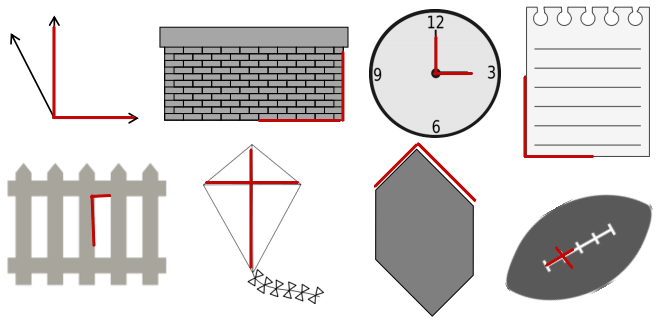
When two distinct lines intersect each other at 90 degrees those lines are called perpendicular lines. A right angle is also known as perpendicular lines. In the above images, we have traced out the perpendicular lines and the properties of perpendicular lines are these lines should always intersect at right angles. So if the two lines are perpendicular to the same line then those lines will be parallel to each other and will never intersect.
Question 2.
How do you know if two lines are perpendicular?
Answer:
When two distinct lines intersect each other at 90 degrees those lines are called perpendicular lines. A right angle is also known as perpendicular lines. And the properties of perpendicular lines are these lines should always intersect at right angles. So if the two lines are perpendicular to the same line then those lines will be parallel to each other and will never intersect.
Question 3.
In the square and triangular grids below, use the given segments in each grid to draw a segment that is perpendicular using a straightedge.
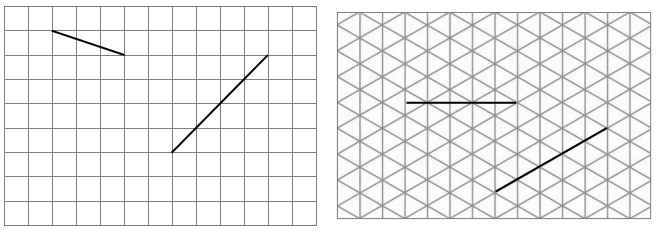
Answer:
As two distinct lines intersect each other at 90 degrees those lines are called perpendicular lines. A right angle is also known as perpendicular lines. And the properties of perpendicular lines are these lines should always intersect at right angles. So if the two lines are perpendicular to the same line then those lines will be parallel to each other and will never intersect.
Explanation:
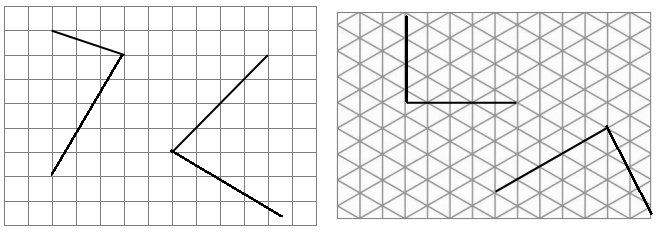
In the above image, we have constructed the perpendicular lines, as two distinct lines intersect each other at 90 degrees those lines are called perpendicular lines. A right angle is also known as perpendicular lines. And the properties of perpendicular lines are these lines should always intersect at right angles. So if the two lines are perpendicular to the same line then those lines will be parallel to each other and will never intersect.
Question 4.
Use the right angle template that you created in class to determine which of the following figures have a right angle. Mark each right angle with a small square. For each right angle, you find, name the corresponding pair of perpendicular sides. (Problem 4(a) has been started for you.)

Answer:
The perpendicular angles in the image a are <AB and <BD, <BD and <CD, <CD and <CA, <CA and <AB.
There are no perpendicular angles in image b as there are no right angles.
The perpendicular angles in the image c are <GE and <EF
There are no perpendicular angles in the image d as there are no right angles.
The perpendicular angles in the image e are <AW and <WF, <WF and <FZ, <FZ and <ZH, <AZ and <AW
There are no perpendicular angles in the image f as there are no right angles.
There are no perpendicular angles in the image g as there are no right angles.
The perpendicular angles in the image h are <VW and <WX, <WX and <XY, <YU, and <UV.
Explanation:
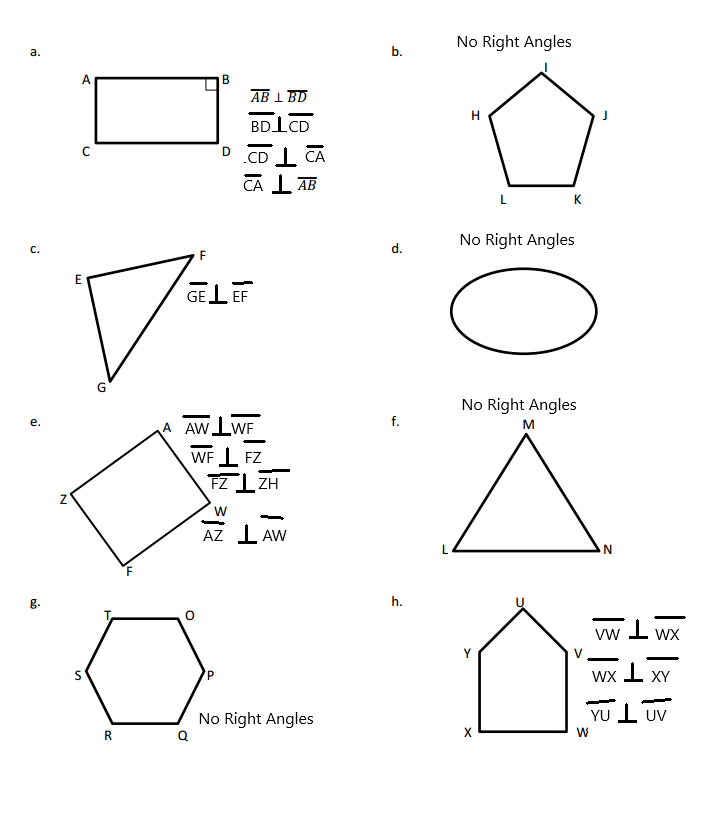
As two distinct lines intersect each other at 90 degrees those lines are called perpendicular lines. A right angle is also known as perpendicular lines. And the properties of perpendicular lines are these lines should always intersect at right angles. So if the two lines are perpendicular to the same line then those lines will be parallel to each other and will never intersect. As in the above image a is a square the perpendicular angles are <AB and <BD, <BD and <CD, <CD and <CA, <CA and <AB. And in image b we can see that the image is polygon so there will be No Right Angles. In image c we can see some angles, so the perpendicular angles are <GE and <EF. In image d there will be No Right Angles as there as it is in oval shape and no angles in that image. In image e, there are some angles, so the perpendicular angles are <AW and <WF, <WF and <FZ, <FZ and <ZH, <AZ and <AW. In image f, there are no angles, so there will be no perpendicular angles as there are No Right Angles. In image g there are no angles, so there will be no perpendicular angles as there are No Right Angles. In image e, there are some angles, so the perpendicular angles are <VW and <WX, <WX and <XY, <YU, and <UV.
Question 5.
Mark each right angle on the following figure with a small square. (Note: A right angle does not have to be inside the figure.) How many pairs of perpendicular sides does this figure have?
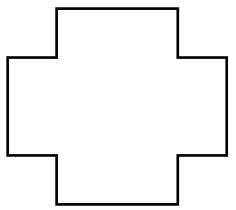
Answer:
There are 12 pairs of perpendicular sides.
Explanation:
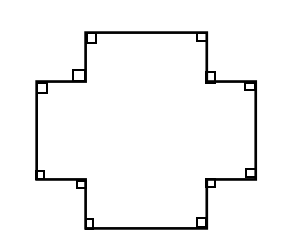
As two distinct lines intersect each other at 90 degrees those lines are called perpendicular lines. A right angle is also known as perpendicular lines. And the properties of perpendicular lines are these lines should always intersect at right angles. So if the two lines are perpendicular to the same line then those lines will be parallel to each other and will never intersect. So in the above image, we can see that there are 12 pairs of perpendicular sides.
Question 6.
True or false? Shapes that have at least one right angle also have at least one pair of perpendicular sides. Explain your thinking.
Answer:
Yes, it is true. As the right angles are created by sides that are perpendicular, so if a figure has a right angle it must have perpendicular sides.
Eureka Math Grade 4 Module 4 Lesson 3 Exit Ticket Answer Key
Use a right angle template to measure the angles in the following figures. Mark each right angle with a small square. Then, name all pairs of perpendicular sides.
Question 1.

Answer:
In the above image a is a square the perpendicular angles are <BC and <CD, <ED and <DC, <AE and <AB.
Explanation:
As two distinct lines intersect each other at 90 degrees those lines are called perpendicular lines. A right angle is also known as perpendicular lines. And the properties of perpendicular lines are these lines should always intersect at right angles. So if the two lines are perpendicular to the same line then those lines will be parallel to each other and will never intersect. As in the above image a is a square the perpendicular angles are <BC and <CD, <ED and <DC, <AE and <AB.
Question 2.
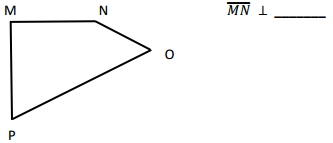
Answer:
In the above image a is a square the perpendicular angles are <MN and <MP.
Explanation:
As two distinct lines intersect each other at 90 degrees those lines are called perpendicular lines. A right angle is also known as perpendicular lines. And the properties of perpendicular lines are these lines should always intersect at right angles. So if the two lines are perpendicular to the same line then those lines will be parallel to each other and will never intersect. As in the above image a is a square the perpendicular angles are <MN and <MP.
Eureka Math Grade 4 Module 4 Lesson 3 Homework Answer Key
Question 1.
On each object, trace at least one pair of lines that appear to be perpendicular.
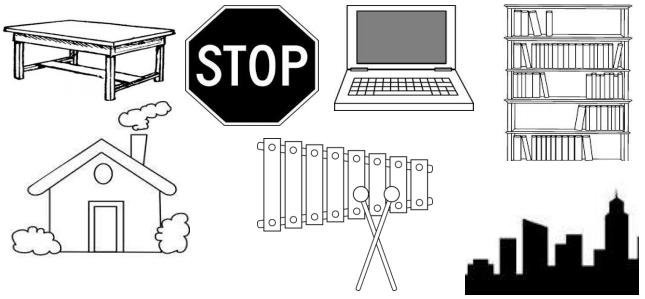
Answer:
Refer below to check the perpendicular angles which are traced for the images.
Explanation:
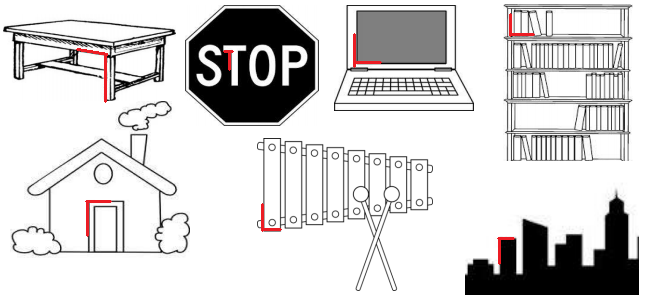
As two distinct lines intersect each other at 90 degrees those lines are called perpendicular lines. A right angle is also known as perpendicular lines. And the properties of perpendicular lines are these lines should always intersect at right angles. So if the two lines are perpendicular to the same line then those lines will be parallel to each other and will never intersect. In the above image, we have traced the perpendicular angles of the images.
Question 2.
How do you know if two lines are perpendicular?
Answer:
When two distinct lines intersect each other at 90 degrees those lines are called perpendicular lines. A right angle is also known as perpendicular lines. And the properties of perpendicular lines are these lines should always intersect at right angles. So if the two lines are perpendicular to the same line then those lines will be parallel to each other and will never intersect. By that, we will get to know that two lines are perpendicular.
Question 3.
In the square and triangular grids below, use the given segments in each grid to draw a segment that is perpendicular. Use a straightedge.
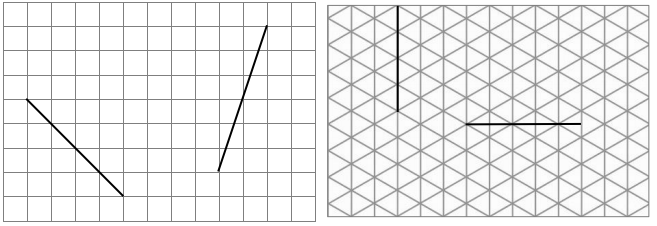
Answer:
As two distinct lines intersect each other at 90 degrees those lines are called perpendicular lines. A right angle is also known as perpendicular lines. And the properties of perpendicular lines are these lines should always intersect at right angles. So if the two lines are perpendicular to the same line then those lines will be parallel to each other and will never intersect.
Explanation:
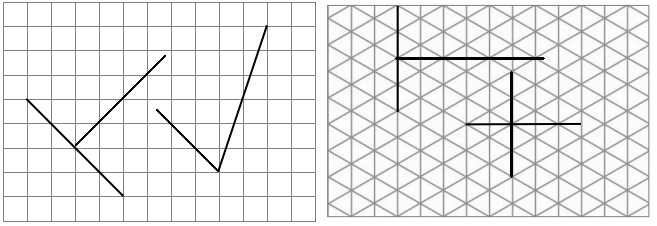
In the above image, we have constructed the perpendicular lines, as two distinct lines intersect each other at 90 degrees those lines are called perpendicular lines. A right angle is also known as perpendicular lines. And the properties of perpendicular lines are these lines should always intersect at right angles. So if the two lines are perpendicular to the same line then those lines will be parallel to each other and will never intersect.
Question 4.
Use the right angle template that you created in class to determine which of the following figures have a right angle. Mark each right angle with a small square. For each right angle you find, name the corresponding pair of perpendicular sides. (Problem 4(a) has been started for you.)
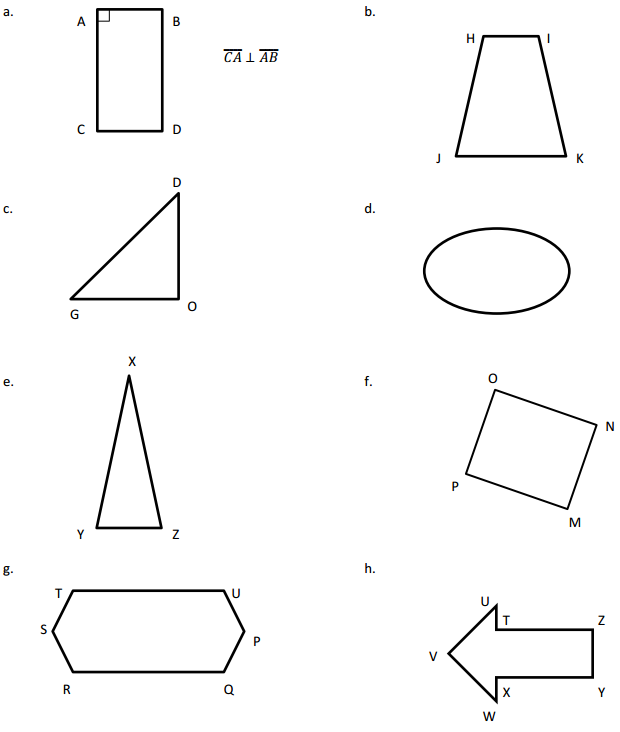
Answer:
The perpendicular angles in the image a are <CA and <AB, <AB and <BD, <BD and <CD, <CD and <AC.
There are no perpendicular angles in image b as there are no right angles.
The perpendicular angles in the image c are <DO and <GO.
There are no perpendicular angles in the image d as there are no right angles.
There are no perpendicular angles in image e as there are no right angles.
The perpendicular angles in the image f are <ON and <NM, <ON and <OP, <PM and <OP, <PM and <MN.
There are no perpendicular angles in the image g as there are no right angles.
The perpendicular angles in the image h are <UV and <VW, <US and <SZ, <WY and <XY, <SZ and <ZY, <XY and <YZ.
Explanation:

As two distinct lines intersect each other at 90 degrees those lines are called perpendicular lines. A right angle is also known as perpendicular lines. And the properties of perpendicular lines are these lines should always intersect at right angles. So if the two lines are perpendicular to the same line then those lines will be parallel to each other and will never intersect. As in the above image a is a square the perpendicular angles are <CA and <AB, <AB and <BD, <BD and <CD, <CD and <AC. And in image b we can see that the image is polygon so there will be No Right Angles. In image c we can see some angles, so the perpendicular angles are <DO and <GO. In image d there will be No Right Angles as there as it is in oval shape and no angles in that image. In image e, there are no angles, so there will be no perpendicular angles as there are No Right Angles. In image f, there are some angles, so the perpendicular angles are <ON and <NM, <ON and <OP, <PM and <OP, <PM and <MN. In image g, there are no angles, so there will be no perpendicular angles as there are No Right Angles. In image h, there are some angles, so the perpendicular angles are <UV and <VW, <US and <SZ, <WY and <XY, <SZ and <ZY, <XY and <YZ.
Question 5.
Use your right angle template as a guide, and mark each right angle in the following figure with a small square. (Note: A right angle does not have to be inside the figure.) How many pairs of perpendicular sides does this figure have?
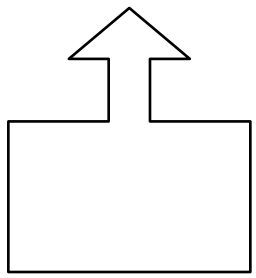
Answer:
In the above image, we can see that there are 9 pairs of perpendicular sides.
Explanation:
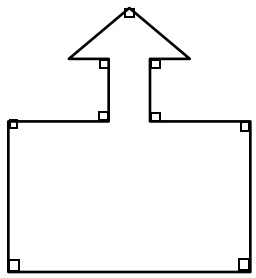
As two distinct lines intersect each other at 90 degrees those lines are called perpendicular lines. A right angle is also known as perpendicular lines. And the properties of perpendicular lines are these lines should always intersect at right angles. So if the two lines are perpendicular to the same line then those lines will be parallel to each other and will never intersect. So in the above image, we can see that there are 9 pairs of perpendicular sides.
Question 6.
True or false? Shapes that have no right angles also have no perpendicular segments. Draw some figures to help explain your thinking.
Answer:
Yes, it is true. As the shapes without right angles have no perpendicular segments because perpendicular lines meet at right angles. So the rhombus has equal sides but no right angles and no perpendicular segments.